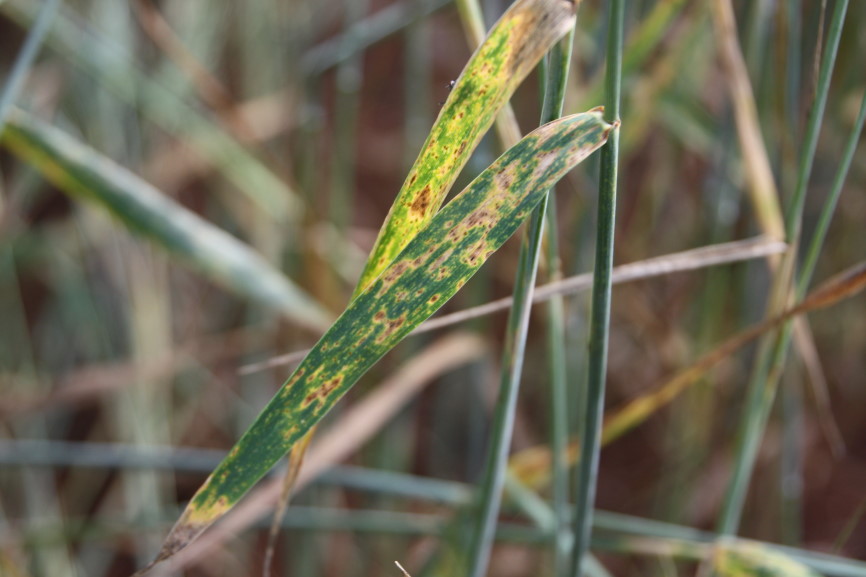
Agricultural News
OSU Pathologist Dr. Bob Hunger Seeing a Variety of Disease Issues Late in the 2020 Wheat Growing Season
Sun, 10 May 2020 15:03:50 CDT
 This past week was quite cool across Oklahoma (mid 60s F in Stillwater today) and central Oklahoma received needed rain. Unfortunately, western OK and the panhandle were not as fortunate and remain dry. Wheat around Stillwater this week was as far along as the milk to soft dough stage; wheat today at Lahoma in north-central OK ranged considerably but was as far along as approaching full kernel but watery.
This past week was quite cool across Oklahoma (mid 60s F in Stillwater today) and central Oklahoma received needed rain. Unfortunately, western OK and the panhandle were not as fortunate and remain dry. Wheat around Stillwater this week was as far along as the milk to soft dough stage; wheat today at Lahoma in north-central OK ranged considerably but was as far along as approaching full kernel but watery.
Stripe rust has fairly well shut down across the state as indicated by turning to the telial spore stage-see 27-April update- available here, and although this cool weather with rainfall and dew in central OK will favor stripe rust, I doubt if we will stay sufficiently cool and wet for stripe rust to pick up again across Oklahoma (plus, northwestern OK and the panhandle remain dry). However, leaf rust has started to become more prevalent over this past week and likely will continue to increase in areas where there is rainfall or dew formation. This past week around Stillwater, both Dr. Brett Carver and I were able to rate plots and trials around Stillwater for leaf rust incidence and severity. Additionally this past week here at Stillwater for the first time in about a decade, I found wheat stem rust. Recall there are three wheat rusts including stripe rust, leaf rust, and stem rust. Stem rust is rare in Oklahoma and is only observed in years when we have an extended cool spring (much like this one). In contrast to the implication of its name, stem rust can occur on leaves as well as on stems, whereas pustules of stripe rust and leaf rust are more typically found on leaves.
Leaf browning also is still apparent around much of the state and has multiple causes this year as discussed in the April 27th Disease update- again available here. These causes include leaf spot diseases, freeze, drought, necrosis (tissue death) due to a resistant reaction to stripe rust, and even a browning due to an unknown physiological factor. Over this past week, both Dr. Brett Carver and I have observed another possible cause of leaf browning, which is bacterial streak. Bacterial streak isn't usually a significant problem in Oklahoma, but occasionally has been observed in low to moderate incidence. It causes not only a browning of leaves (but without the "pepper spots" as with Septoria/Stagonospora), but also can cause a darkening of the heads (black chaff). As I said, we have not confirmed bacterial streak to be present, but it is a possibility.
Finally, it is worth mentioning that a number of individuals have reported seeing a higher incidence of wheat heads with loose smut this year. This agrees with what Dr. Carver, Dr. Amanda de Oliveira Silva, and I have seen. Spores of the loose smut fungus are released in the field when wheat is flowering. The spores infect the fertilized seed and are carried within the seed. If this infected seed is used to plant the next year's crop, the growing plant from that seed will be infected and produce loose smutted heads in the spring hence, completing the disease cycle. The ways to avoid problems from loose smut are to (1) not save seed wheat from fields in which loose smut is present, and (2) plant seed wheat treated with a fungicide labeled for use to manage loose smut. Many such seed treatments are available. I need to point out that if you have a field this year with loose smut and you plant treated wheat in this field next year, there may still be some loose smut-infected plants the next spring. These infected plants would not be from the treated seed wheat, but are volunteer plants from the previously infected crop. If you have questions about the bunts and smuts please contact your local county extension educator or me.
To review the report- complete with photos- click on the PDF file below
00100_Bob_Hunger_Wheat_Disease_Update_05092020.pdf
WebReadyTM Powered by WireReady® NSI
Top Agricultural News
More Headlines...





